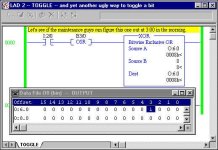Allen,
The latch is reset on a first scan so I also need on the unlatch to be able to latch a reset bit which is why I've used a latch and unlatch.
Hope that makes sense
The latch is reset on a first scan so I also need on the unlatch to be able to latch a reset bit which is why I've used a latch and unlatch.
Hope that makes sense
I:1/0 B3/0 ---------------
|------] [-----[OSR]-------|CTU |----(CU)---|
| |Counter C5:0 | |
| |Pre 2 |----(DN)---|
| |Acc 0 | |
| --------------- |
| --------------- O:2.0 |
|------|EQU |-------------------------(L)---|
| |Sour C5:0.acc| |
| |Sour 1|
| --------------- |
| --------------- O:2.0 |
|------|EQU |-------------------------(U)---|
| | |Sour C5:0.acc| | | |
| | |Sour 2| | | |
| | --------------- | | -------------- |
| | First scan | |---|MOV |--|
| ------] [------------ | |Source 0| |
| | |DestC5:0.acc| |
| | -------------- |
| | |
| -------------(L)----|








